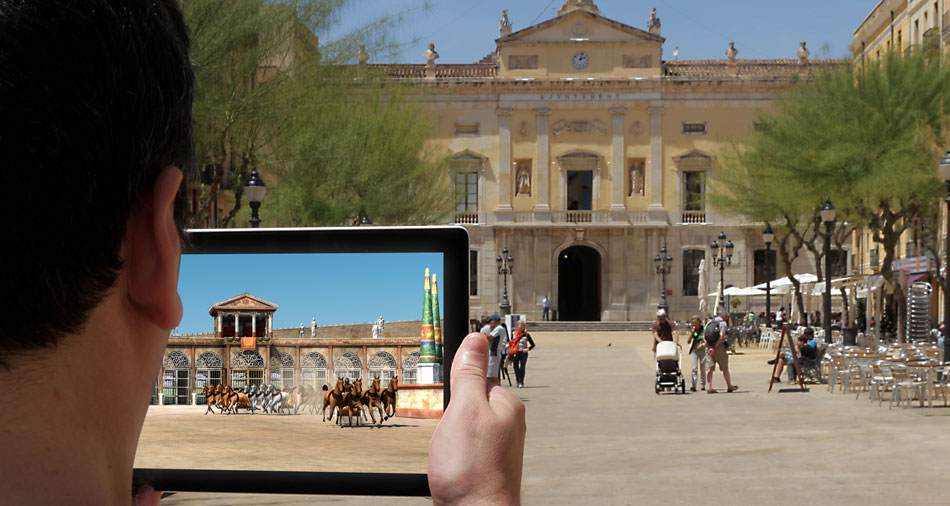Vivimos momentos convulsos, momentos de incertidumbre, momentos de reactivación. La pandemia nos ha dejado una nueva realidad, una realidad a la que poco a poco nos vamos acostumbrando, una realidad que cambia día a día, a la que estamos habituando nuestra manera de disfrutar, nuestra manera de compartir, nuestra manera de viajar.
Una manera de viajar donde el turista post-covid busca experiencias diferentes, pero, sobre todo, experiencias que le ofrezcan seguridad.
EL VIAJERO EN LA ERA POST COVID
Sin duda son varios los aspectos en los que los viajeros van a cambiar en el corto y medio plazo. Según se desprende del último Barómetro Turístico de BRAINTRUST, los destinos que se elijan y los tipos de viaje que se hagan serán los aspectos más impactados y los que más cambiarán en este nuevo contexto.
ASPECTOS QUE VAN A CAMBIAR EN LA MANERA DE VIAJAR
(Fuente: Barómetro BRAINTRUST 2020. n=1.507)
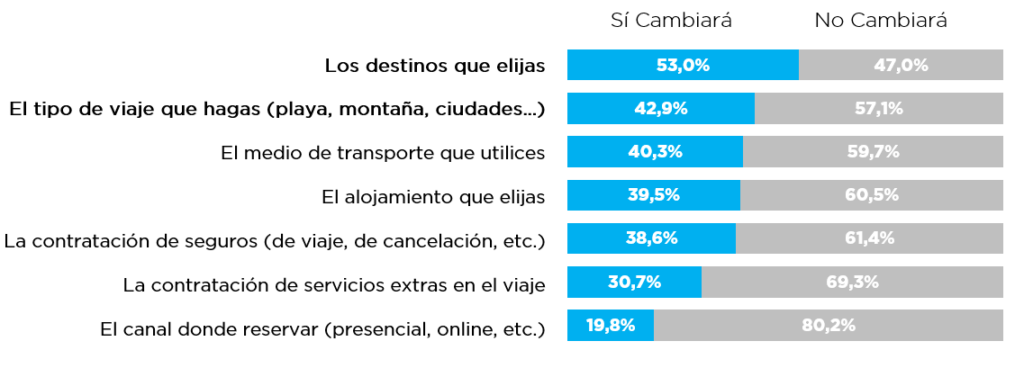
ASPECTOS QUE VAN A CAMBIAR EN LA MANERA DE VIAJAR
Como se puede observar, más de la mitad de los potenciales turistas van a cambiar el tipo de destino. Pero ¿en qué sentido? El Barómetro también ofrece respuestas a esta pregunta
TIPOS DE DESTINOS QUE SE VAN A ELEGIR EN EL FUTURO
(Fuente: Barómetro BRAINTRUST 2020. n=799)
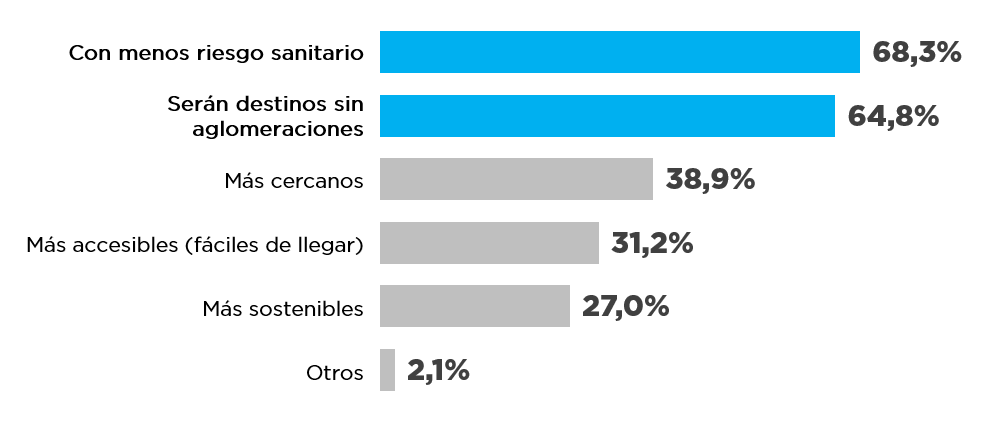
TIPOS DE DESTINOS QUE SE VAN A ELEGIR EN EL FUTURO
Dos aspectos destacan por encima del resto: se van a buscar destinos con menos aglomeraciones y con menor riesgo sanitario. Por tanto, corresponde a los destinos dar respuesta a estas demandas de los viajeros, buscando la forma de reducir la concentración de personas (sin por ello limitar el número de viajeros) y poner todos los mecanismos para asegurar (y transmitir) el menos riesgo sanitario.
En lo que respecta a los tipos de viaje, se observa que a priori aumentan los viajes asociados a naturaleza y entornos rurales y se prevé que disminuyen los que tienen un carácter más urbano (descenso más acusado en el caso de los viajes asociados a ocio/compras que en el caso de los asociados a patrimonio/cultura)
RETOS DE LOS DESTINOS
Actualmente muchos destinos están haciendo esfuerzos por atraer al turista nacional apoyándose en entornos naturales, ambientes muy tranquilos y poca concentración turística.
Sin embargo, la realidad en el medio plazo puede no ser tan sencilla. Lo cierto es que muchas de nuestras ciudades concentran gran cantidad de visitantes en unos pocos puntos de interés, generando aglomeraciones y masificación, no tanto por la cantidad de turistas que acogen, sino por el nivel de concentración que tienen en un número muy limitado de puntos de interés turístico.
A modo de ejemplo se puede mostrar un análisis efectuado por GCPH que refleja como en elementos patrimoniales el Acueducto de Segovia o la Mezquita de Córdoba concentran en un año el triple de personas de las que pernoctan en la ciudad
NIVEL DE SATURACIÓN DE LOS PUNTOS DE INTERÉS EN GCPHE
(Fuente: 1º Observatorio GCPH. www.gcphe.es)
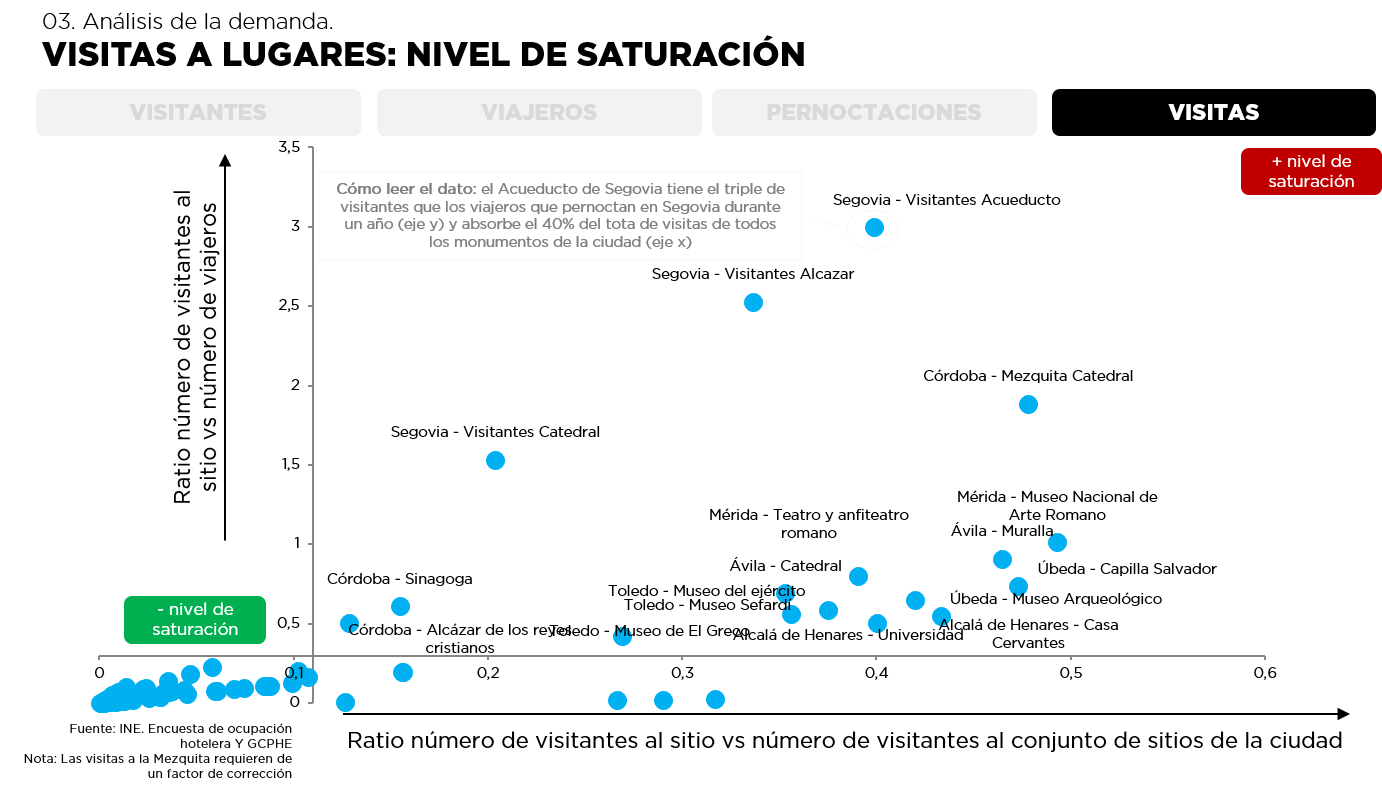
NIVEL DE SATURACIÓN DE LOS PUNTOS DE INTERÉS EN GCPHE
Este hecho supone un problema a corto plazo lógicamente por la sensación de aglomeración y menor seguridad sanitaria: Pero también es un problema a largo plazo, pues una excesiva concentración genera rechazo al turista por parte de los residentes y una mala experiencia.
Por tanto, uno de los primeros retos de los destinos es ser capaces de diversificar su oferta, de forma que se generen más puntos de interés en su entorno y sean capaces de atraer a más viajeros con menos aglomeraciones y, adicionalmente, facilitar la repetición y el aumento de la estancia, ya que, al proponer una oferta más amplia, el viajero tendrá más motivos para volver y/o quedarse más tiempo en el destino.
Además de la concentración, se identifican otras palancas concretas que harían que los viajeros se decidiesen a hacer un viaje en los próximos meses:
PALANCAS PARA ELEGIR UN DESTINO
(Fuente: Barómetro BRAINTRUST 2020. n=750)
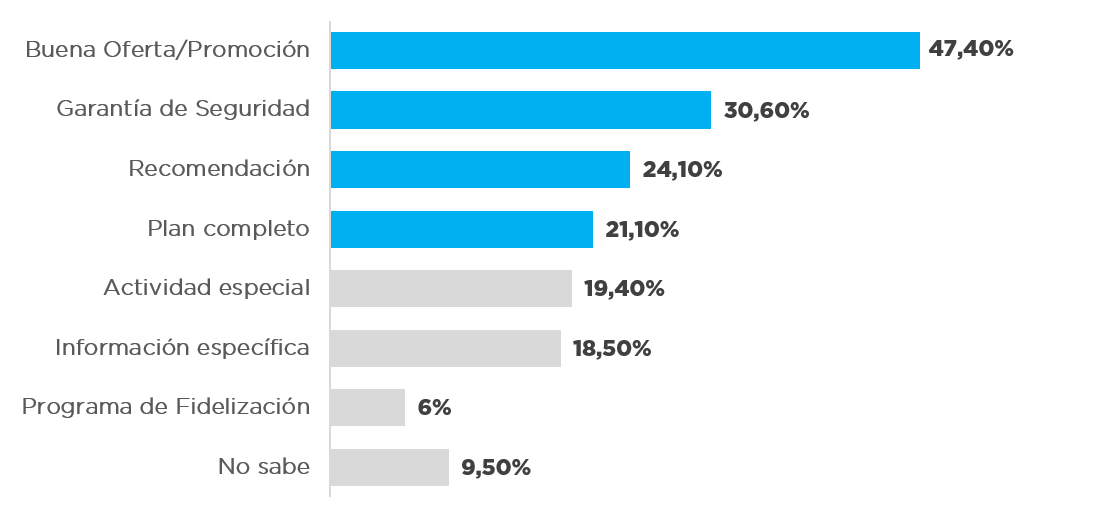
PALANCAS PARA ELEGIR UN DESTINO
Preguntando a los potenciales viajeros acerca de qué podría hacer un destino para incentivarle a visitarlo, la primera respuesta es efectuarle una buena oferta o promoción (reflejo del impacto económico que la crisis puede tener en el turismo), pero más allá de esta palanca convendría destacar las vinculadas con ofrecer un plan completo o una actividad especial (40% entre ambas) y, por supuesto, proporcionar garantía de seguridad (sanitaria).
Por tanto, y a la vista de los resultados anteriores, parece que tres de las principales recomendaciones que se podrían realizar a los destinos serían:
- Evitar aglomeraciones -> a través de una adecuada gestión de los visitantes y sobre todo a través de la diversificación de la oferta. Desplazar de forma inteligente a los visitantes a puntos de interés diferentes, en localizaciones relativamente dispersas, es clave para conseguir minimizar la excesiva concentración de turistas sin que ello signifique una disminución del volumen de los que vistan la ciudad.
- Darles planes que hacer -> proporcionar al viajero contenido para la visita. La mayoría de nosotros necesitamos “excusas” para decidir visitar un destino y tener la posibilidad de hacer un plan completo en el mismo. No se trata de visitar la ciudad X, sino de ir a X a hacer una ruta, una cata, ver una exposición, ver tal punto de interés o lo que sea… Estos elementos complementarios son los determinan en muchos casos la intención de visitar. Y la generación de nuevos puntos de interés es clave en este sentido.
- Experiencia digital -> esencialmente en dos aspectos, complementarios, pero con alcance diferente:
- Información y gestión: implementar canales digitales que permitan “comunicarse” con el viajero de forma eficiente y segura, y hacer una gestión activa de los mismos para poder optimizar sus intereses y los del destino.
- Experiencia en la visita: dotar a las diferentes experiencias que se pueden vivir en el destino, de componentes digitales que ofrezcan nuevas perspectivas y contribuyan a diferenciar al destino a través de elementos seguros, sostenibles, etc.
IMAGEEN+BRAINTRUST
IMAGEEN, empresa líder en la explotación del turismo cultural a través de las nuevas tecnologías (http://www.imageen.net) y BRAINTRUST (https://www.braintrust-cs.com), multinacional líder en el ámbito de la consultoría turística, han unido sus fuerzas para desarrollar un producto digital que, apoyándose en el desarrollo de entornos virtuales de realidad aumentada consiguen transformar el turismo de los destinos adaptándolo a la nueva era.
EN QUÉ CONSISTE LA SOLUCIÓN
IMAGEEN ofrece al visitante y al propio ciudadano experiencias inmersivas con su propio dispositivo móvil (Smartphone o Tablet) que le permiten visitar el pasado de los monumentos o de las distintas partes de la ciudad, revivir acontecimientos históricos que allí han ocurrido, o comprender con tecnologías didácticas e interactivas curiosidades o detalles de los monumentos o lugares que se visitan.
Esta nueva solución tiene un enfoque integral, buscando la inmersión del turista a través de la realidad aumentada en los diferentes puntos de interés de la ciudad, interactuando en diferentes entornos, transportándolo a diferentes épocas y viviendo una nueva forma de hacer turismo.
BRAINTRUST+IMAGEEN implantan estos proyectos en cinco etapas, que logran al final del proceso mejorar los indicadores de cualquier destino turístico:

Etapas implantación Proyectos – BRAINTRUST + IMAGEEN
En la primera de las fases se efectúa un diagnóstico del destino: principales puntos de interés actuales, puntos de interés potenciales, nivel de saturación actual, otros problemas existentes, etc.
Con el resultado del diagnóstico se identifican potenciales puntos de interés a desarrollar digitalmente, valorando el impacto que podría tener cada uno de ellos y definición un plan de acción, que podría incorporar la búsqueda de la financiación necesaria para su desarrollo.
Una vez concretada la actuación, la tercera de las fases sería la construcción de los contenidos digitales para el punto y su implantación (formación, verificación del funcionamiento, etc.)
Las dos últimas fases estarían destinadas a confirmar el funcionamiento y cuantificar los resultados del proyecto (en términos económicos, de sostenibilidad, de experiencia del turista, etc.)
En definitiva, esta solución da respuesta, a través de un análisis previo exhaustivo detectando los principales problemas y oportunidades del destino, a las necesidades actuales de gestión del turismo, nuevas experiencias, diversificación y seguridad, creando esos espacios seguros tan demandados en esta “nueva normalidad” que nos ha tocado vivir.
CÓMO PUEDE AYUDAR LA SOLUCIÓN IMAGEEN+BRAINTRUST
Para un destino, la implantación de esta solución aporta innumerables beneficios, entre los cuales cabría destacar los que más directamente inciden en este nuevo tipo de viajero
- Diversificación de la oferta, ampliando la propuesta de valor con nuevos planes y actividades, lo que, como se han mencionado, es uno de los aspectos clave que pueden atraer a los nuevos viajeros. Planes completos, actividades especiales, en definitiva “excusas” para visitar un destino.
- Mejor gestión de los visitantes, generando nuevos puntos de interés y reduciendo las aglomeraciones. Este punto es clave, pues como se ha visto en la actualidad, muchas de los destinos tienen capacidad de acoger a más viajeros, pero la concentración en determinados puntos de interés hace que la sensación de saturación y aglomeración se elevada.
- Mejora de la experiencia, tanto por permitir ver los sitios “de otra forma” como por una gestión más adecuada de las personas y el patrimonio.
- Atracción de nuevos viajeros. El ampliar la propuesta de valor, con elementos diferenciales y de interés (además de fácilmente comunicables), puede ayudar a los destinos a atraer más visitantes, en un momento en el que esto es clave para las economías locales.
Por supuesto, a estos beneficios se podrían añadir los siguientes
- Mayor conocimiento e interacción con los turistas. La solución desarrollada, permite interactuar con los visitantes a través de la realidad aumentada, posibilitando una mejor gestión que ayude a mejorar la experiencia en el corto y en el medio plazo
- Conocer opiniones de los usuarios para adaptar la oferta turística. En el momento en el que vivimos, el poder recoger feedback permanente de los viajeros es un elemento clave, que ayuda a los destinos a mejorar permanentemente su oferta de valor
- Mejora la imagen del destino y marca turística con un enfoque digital estratégico La implantación de este tipo de soluciones supone un salto radical en la imagen y el posicionamiento de la marca del destino, convirtiéndolo en referencia tanto nacional como internacional.
- Desestacionalización, ya que la nueva propuesta de valor puede ser un elemento clave para llegar a segmentos de mercado en los que anteriormente no se estaba presente, o servir de excusa para atraer viajeros fuera de las temporadas habituales incidiendo de nuevo en la sostenibilidad de los destinos.
- Diversificación (orígenes). La posibilidad de ofrecer planes diferentes y experiencias completas permite atraer un tipo de turista que actualmente quede fuera del alcance del destino, con una mayor carga cultural y posiblemente con gasto medio superior.
- Aumento de la estancia media, fruto de tener la posibilidad de desarrollar más experiencias en el destino. La incorporación de diferentes actividades facilita que los viajeros decidan permanecer más días en la ciudad para poder aprovechar todo lo que ofrece.
- Aumento del gasto. Muy unido a las dos anteriores, la atracción de un tipo de turista diferente y la posibilidad de que prolongue su estancia, no hace más que contribuir a elevar el gasto que hace en la ciudad, con el beneficio que eso tiene para la economía y los ciudadanos locales.
- Fomento de la repetición. La incorporación de más puntos de interés puede incentivar a la repetición a los destinos. Y más cuando se conocen y se ha disfrutado de una buena experiencia.
En definitiva, la implantación de esta solución puede permitir a los destinos transformar completamente su turismo, adaptándose al nuevo viajero y a la nueva realidad que nos espera tanto a medio como a largo plazo.
PARA MÁS INFORMACIÓN
BRAINTRUST: info@braintrust-cs.com



